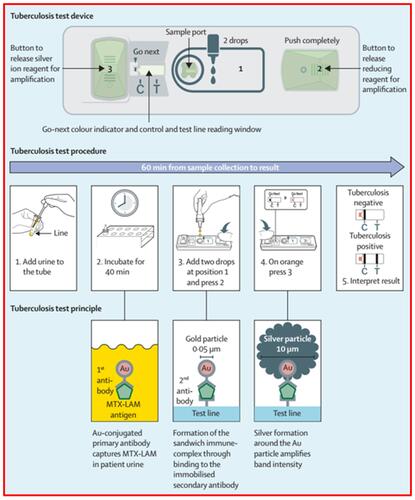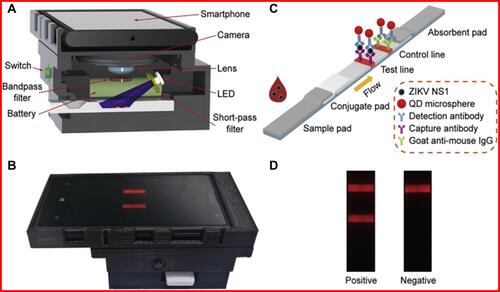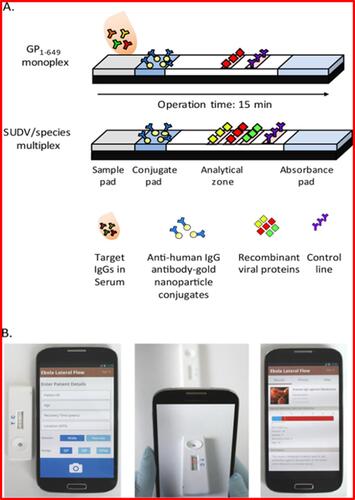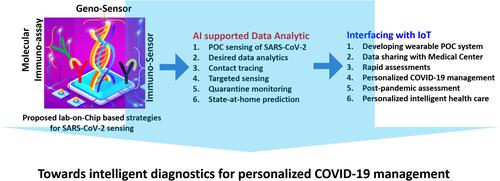Figures & data
Table 1 List of Some Commercially Available POCs for Qualitative Diagnosis of Various Infectious Diseases
Figure 1 Rapid diagnostic platform for Dengue and Chikungunya using (A) multiplex lateral flow test strip, (B) optical reader for color detection, (C) structural representation of optical reader, (D) lightproof casing of optical reader, and (E) appearance of test strip corresponding to different diagnostic scenarios.
Note: Reproduced with the permission from Wang R, Ongagna-Yhombi SY, Lu Z, Centeno-Tablante E, Colt S, Cao X, Ren Y, Caardenas WB, Mehta S, Erickson D. Rapid diagnostic platform for colorimetric differential detection of dengue and Chikungunya viral infections. Analytical chemistry. 2019 21;91(8):5415-23. Copyright (2019) American Chemical Society. Citation82

Figure 2 Schematic representation of novel lipoarabinomannan POC device for Tuberculosis diagnosis and its working principle.Note: Reproduced with the permission form Broger T, Sossen B, du Toit E, Kerkhoff AD, Schutz C, Reipold EI, Ward A, Barr DA, Macé A, Trollip A, Burton R. Novel lipoarabinomannan point-of-care tuberculosis test for people with HIV: a diagnostic accuracy study. The Lancet Infectious Diseases. 2019 Aug 1;19(8):852-61. Copyright (2019) Elsevier.Citation95

Figure 3 Interdigitated electrodes cultured with Astrocytes and infected by HIV in the presence of cocaine to understand the electrochemical assessment of cell physiology.
Note: Reproduced with the permission from Kaushik A, Vabbina PK, Atluri V, Shah P, Vashist A, Jayant RD, Yandart A, Nair M. Electrochemical monitoring-on-chip (E-MoC) of HIV-infection in presence of cocaine and therapeutics. Biosensors and Bioelectronics. 2016 86:426–31. Copyright (2016) Elsevier.Citation130

Figure 4 Illustration of an interdigitated electrodes based immunosensor for the detection of ZIKA protein at (pM), to perform POC diagnostics, this sensing chip is projected to be operated by a miniaturized analyzer and data analysis using internet of medical things.
Note: Reproduced with the permission from Kaushik A, Yndart A, Kumar S, Jayant RD, Vashist A, Brown AN, Li CZ, Nair M. A sensitive electrochemical immunosensor for label-free detection of Zika-virus protein. Scientific reports. 2018 8: 97000. Copyright (2018) Scientific Reports under Creative Commons Attribution 4.0 International License.Citation143

Figure 5 Design and applicability of smartphone-based fluorescent lateral flow immunoassay (LFIA) platform: (A) 3D schematic of internal structure of the device, (B) image of fluorescent LFIA reader, (C) schematic representation of ZIKV NS1 detection using fluorescent LFIA, and (D) images of test strips in the absence (right) and presence (left) of ZIKV NS1.
Note: Reproduced with the permission from Rong Z, Wang Q, Sun N, Jia X, Wang K, Xiao R, Wang S. Smartphone-based fluorescent lateral flow immunoassay platform for highly sensitive point-of-care detection of Zika virus nonstructural protein 1. Analytica chimica acta. 2019 1055:140–7. Copyright (2019) Elsevier.Citation146

Figure 6 Overview of smartphone-based lateral flow POC test for detection of Ebola-specific antibodies illustrating (A) lateral flow strips and (B) smartphone applicationinterface login window for providing a description of the test and further recording of patient details.
Note: Reproduced with the permission from Brangel P, Sobarzo A, Parolo C, Miller BS, Howes PD, Gelkop S, Lutwama JJ, Dye JM, McKendry RA, Lobel L, Stevens MM. A serological point-of-care test for the detection of IgG antibodies against Ebola virus in human survivors. ACS nano. 2018 12(1):63-73. Copyright (2018) American Chemical Society.Citation152

Figure 7 Strategic illustration of developing a miniaturized COVID-19 diagnostics tool for POC application.
Note: Reproduced with the permission from Mujawar MA, Gohel H, Bhardwaj SK, Srinivasan S, Hickman N, Kaushik A. Aspects of nano-enabling biosensing systems for intelligent healthcare; towards COVID-19 management. Materials Today Chemistry. 2020 5:100306. Copyright (2020) Elsevier.Citation154

